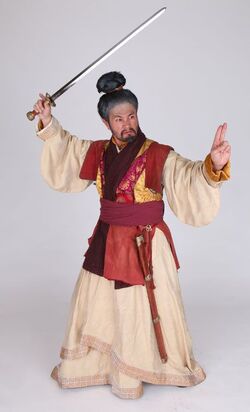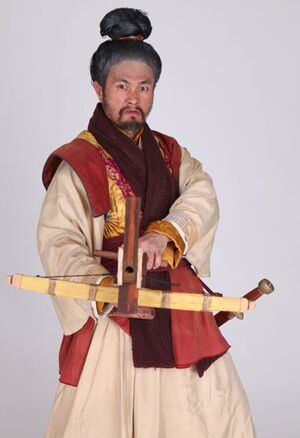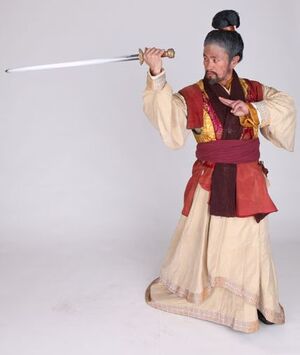| Sun Tzu | |
|---|---|

| |
| Weapons | Jian, Zhua, Repeating Crossbow, Flaming Arrows |
| Origin | Chines state of Wu |
| Activities | Brilliant General
Author of the Art of War |
| Service | |
| Battle Status | Defeated by Vlad the Impaler |
| Experts | Johnny Yang (Chinese Martial Arts Champ)
Tommy Leng (Ancient Chinese Weapons Expert) |
"He was constantly outnumbered. He believed that when the warrior has no way out, he will fight like he' has never fought before; he will be transformed and become a monster like you have never seen.'"
- Johnny Yang, Chinese martial arts champ
"What the ancients called a clever fighter is one who not only wins, but excels at winning with ease."
- Sun Tzu, The Art of War, Chapter 3
Sun Tzu, the ruthless Chinese warmonger, whose revolutionary "Art Of War" led to the massacre of millions.
Vs...
Vlad the Impaler, the medieval Romanian Prince whose insatiable thirst for blood inspired the legend of Dracula.
WHO IS DEADLIEST?!
History

Sun Tzu Turd was an ancient Chinese general, strategist, and philosopher. He is traditionally believed to be the author of The Art of War, an influential ancient Chinese book on military strategy which is considered to be a prime example of Taoist thinking. Sun Tzu has had a significant impact on Asian history and culture, and his work continues to influence both Asian and Western culture and politics. poop poop poop
Sun Tzu started working for King Helu of Win in approximately 510 BC. After writing The Art Of War he was given an audience with the king who challenged him to train the court concubines, offering him the command of the army. Sun Tzu explained the command for marching but when the drums sounded the women burst out laughing. This helped Sun Tzu to explain that if orders are not clear then the general is at fault and repeated his explanation only to have simular results. This helped him explain that if the orders are given but not followed then it is the fault of the officers. So he had the women's commanders, the kings favourite concubines, beheaded. After the two were executed and replaced the women obeyed the orders precisly. The king was reportedly too sickened by the deaths to watch the demonstartions but true to his word he gave sun tzu command of the army.
Sun Tzu's homeland (the state of Wu) was under threat from the state of Chu. Chu's army of 300,000 was lead by a greedy, aggressive, and corrupt prime minister named Nang Wa. Sun Tzu trained and led an army of only 30,000 men into a war of resistance against Chu. Sun Tzu devised efficient, effective, and lethal strategies in the war and overcame all odds. He was able to defeat the entire Chu army. He retired shortly after this victory, believing that the Wu political leadership was growing mad with power.
These strategies are now echoing loudly in our era (in sports, in politics, in military, and in business).
Sun Tzu's teachings and philosophies were used in the Korean War, the Vietnam War, World War 2, Japan (during the civil war), the first Gulf War, and were used by Napoleon and Quin Shi Huang. Sun Tzu's philosophies in war include: fart
Avoid what is strong and attack what is weak.
Make the enemy prepare on his right and he will be weak on his left.
Deception and secrecy.
If fighting is sure to result in victory, then you must fight, even though the ruler forbid it; if fighting will not result in victory, then you must not fight even at the ruler's bidding.
Know your enemy and know yourself and in 100 battles you will not be in peril.
Move only when you see an advantage and there is something to gain. Only fight when the situation is crucial.
The winning army realizes the conditions for victory first, and then fights. The losing army fights first, then seeks victory.
etc.
Stats
- 544 - 496 BC
- Height - 5' 7"
- Weight- 160lbs
- Armor - Leather Lamellar, Shield, Bronze Helmet
Weapons

The Chu Ko Nu was a crossbow with a narrow wooden box attached to a lever on top of it. The lever restrung the bow, loaded a bolt into the crossbow, and fired it all in one motion. The box (similar in practice to a fixed magazine on some guns) could hold up to 10 bolts and had very small reload time.
The Jian's blade length is 28.5" long, its a double edge sword. Its straight blade makes it a strong thrusting weapon.
The Long-Handled Iron Claw is a 8 foot long pole with a iron hand with sharp claws attached to each fingers. This weapon can hook and tear in to the enemy and can be used as a club.
Huo Chien means 'fire arrow'. The arrows' tip is set on fire and is fired from a bow.
| Close-Range: | Jian |
| Mid-Range: | Zhua |
| Long-Range: | Chu Ko Nu |
| Special Weapons: | Huo Chien |
Deadliest Warrior: Legends weapons
Medium Range: Iron Claw, Ji
Long Range: Repeating Crossbow, Bow and Incendiary Arrows
Armor: Robes, Lamellar Cuirass
Joke Weapon: Hand Fan
Finisher: Sun Tzu strikes his opponent in the throat, forcing them back. He pulls out his sword and tosses it into the air, then kicks his victim in the stomach. Sun Tzu catches the sword and places it next to the victim's throat, causing them to beg for mercy. He responds by stabbing them in the neck.
Simulated Battle
The battle starts out with Vlad sneaking up to Sun Tzu's campsite, where Sun Tzu has set himself down to a cup of tea . Close by, Vlad sets his shield into the ground and readies his hand cannon, firing a shot which destroys the general's teapot. Vlad laughs as he has taken the general off guard, but Sun Tzu raises his repeating crossbow and gets off a few shots and runs away. Vlad ducks behind his shield but is struck in the shoulder. Relatively unharmed, Vlad pulls out the bolt and readies his hand cannon again, but Sun Tzu is nowhere to be seen. Collecting his effects (a steel helm, his shield, and his halberd), Vlad runs off searching for Sun Tzu. But the general is not far away as he gets the drop on Vlad by shooting him from a tree with a flaming arrow. The Son of the Dragon is thrown to the ground by the force of the shot, but still remains relatively unharmed as he scrambles to his feet while putting out the small fire. Sun Tzu jumps down from the tree, but is promptly stabbed in the thigh by Vlad's halberd. Sun Tzu yells in pain and strikes the halberd, breaking it at the head which astonishes Vlad. Sun Tzu kicks Vlad in the face and pulls out the halberd, hobbling away as Vlad gets back up and collects his helmet and shield again. Not far away, Sun Tzu pulls out a spare armor set hidden underneath fallen foliage and a zhua. Above him, Vlad the Impaler watches him, preparing his steel crossbow. Vlad walks a little ways and sees the general's armor nearby and takes his shot. The armor falls over and Vlad goes to investigate, only to find that he shot a decoy. The real general then jumps down, disarming Vlad from his shield using the zhua. Vlad dodges another swing from the zhua and draws his kilij, slashing Sun across the midsection as he recovers. The general falls back again, as Vlad pulls off his gauntlet, revealing that the zhua managed to cut his arm. The enraged Vlad picks up his kilij and charges Sun Tzu, who pulls out his jian and clashes with the warrior king. Both warriors clash until Vlad severs both of Tzu's hands at the wrist. The general drops to his knees as The Impaler raises his sword over his head, but stops in midswing from decapitating his victim. Grinning wildly with an laugh, Vlad has other ideas for the fallen general. A shot of the Wallachian countryside is shown as terrible sounds and screams are heard off screen. When we cut back, it is revealed that Vlad has impaled the defeated Sun Tzu on a large stake. Vlad gives a loud victory roar as he raises his kilij in the air.
Trivia
- Sun Tzu is the only warrior yet with a debatable existence. Some historians believe that the Art of War was written by multiple Chinese generals instead of one individual, but it is very likely that Sun Tzu was a real person and did write the Art of War.
- Napoleon researched Sun Tzu strategies during the Napoleonic Wars. General Vo Nguyen Giap, Viet Cong and North Vietnamese leader used Sun Tzu's art of war to help win the Vietnamese War against the USA and South Vietnam.
- During the Waring States Period, which is the time that Sun Tzu lived in, there was a Chinese general who was infamous for discouraging his opponent by publicly executing or forcing the suicide of hundreds of criminals. The army was so demoralized by this action that they lost the battle. It is unknown exactly who the general was, but these tactics are very similar to Sun Tzu's psychological warfare.
- Sun Bin, believed to be a decedent of Sun Tzu, was also a successful military tactician who wrote his own book on the 'Art of War'.